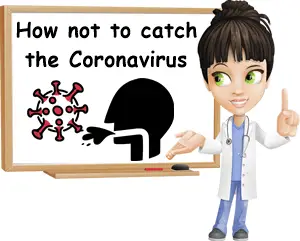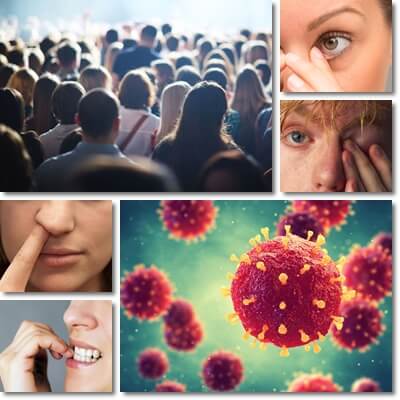It would appear that the novel Coronavirus is here to stay. But SARS-CoV-2, as the 2019 Coronavirus is formally called, is not the only human Coronavirus in existence. Human Coronaviruses HCoV-OC43, HCoV-HKU1, HCoV-229E and HCoV-NL63 are largely responsible for up to 15% of all common cold cases. The species generally cause mild illness in the form of upper respiratory tract infections such as the common cold, although some of them are known to also produce more severe infections such as pneumonia, bronchitis, bronchiolitis or croup and related complications. Human Coronaviruses MERS-CoV, SARS-CoV and SARS-CoV-2 on the other hand tend to produce more severe respiratory infections such as pneumonia. MERS-CoV for instance has a fatality rate of around 30% which clearly means it’s more dangerous that the Coronaviruses responsible for the common cold.
None of the 7 human Coronaviruses currently known to be causing the common cold, pneumonia, bronchiolitis, bronchitis or croup seem to be going anywhere for the time being, the novel Coronavirus (SARS-CoV-2) included. But considering that seniors and anyone with a chronic condition or immune system deficiencies are at risk for severe forms of the disease, it is imperative that we limit the spread of the novel Coronavirus. Choosing to protect those of us most sensitive to complications is good for everyone really because it keeps another major risk at bay – mutations. Because, yes, the novel Coronavirus, like any other virus, has the ability to mutate and can become stronger, more contagious and a source of more severe disease for more than just risk categories.

Just like MERS and SARS were never really over, COVID-19 will never really be over either. It is in times like these that humanity must come together and rally around a common cause: our health. Given the abundance of information we now possess with regards to the current pandemic and how the novel Coronavirus produces infection and what it does the the lungs, heart and other organs and body systems, the goal is to limit the spread of the infection. But how do we stop the novel Coronavirus? Answer: by understanding how it spreads and reducing risk factors of catching it to the best of our efforts. Find out below all the ways in which you can catch the novel Coronavirus.
How does the novel Coronavirus spread?
- Via biological aerosols. Biological aerosols are essentially droplets of water containing virus particles from an infected person, as well as other fluids (e.g. saliva, mucus, phlegm, sputum). They are released by an infected person by coughing or sneezing. There are two kinds: larger droplets that can only travel a small distance and then fall to the ground or on surfaces, and smaller, invisible droplets that travel greater distances, persist in the air and can be inhaled by other people coming into contact with them. Aerosols can cause direct and indirect infection with COVID-19.
- Via fomites, or inanimate objects. These can be contaminated by an infected person via coughing, sneezing, drooling, eating, drinking and any other action that releases contaminated fluids. Objects that commonly transmit COVID-19 may include: door knobs, mobile phones, jewelry, cash (paper and plastic money, but also coins), dishware, cutlery, shared objects (e.g. toys, pens offered to clients at the bank or any other place where there may be paperwork to complete), desks and so on. Depending on the type of surface (paper, wood, plastic, metal etc.), the virus may live for a few hours to a few days on said surface.

Ways to catch the novel Coronavirus?
- By being in proximity to someone who is infected, living, working with or caring for someone who is infected.
- By being in the direction of someone infected who has coughed or sneezed or who spits when talking, within contact distance and up to a few meters (4 to 6 meters).
- By sharing objects with other people such as pens, mobile phones etc.
- By sharing objects that may contain the saliva, mucus, phlegm, sputum or blood of someone who is infected (e.g. dishware, kitchenware, toys etc.).
- By touching objects or surfaces other people have touched (e.g. elevator buttons, door knobs, doors, handrails, desks and any public surfaces, food products at the supermarket etc.).
- Through social practices such as shaking hands, then touching your mouth, nose or eyes without washing your hands first. Also: cheek kissing, hugging.
- By being in crowded public places, whether the supermarket, a bus or train, a farmer’s market, a public market or the doctor’s waiting room.
- By travelling anywhere, whether on vacation or for work, errands, school etc. Travelling puts you in contact with both a great number of people and a great number of potentially contaminated surfaces. The greater the travel distance, the higher the risks of getting and passing on the novel Coronavirus.
Where can you catch the novel Coronavirus?
- In areas with a high number of reported infections. This is why travelling to other countries and vising popular tourist attractions is not very safe right now.
- In highly populated areas: school, kindergarten, work/office, a waiting room, the hospital, the supermarket, farmer’s market, a concert hall, the zoo, a movie theater, a coffee shop, a square, the bus, train, metro or a ship, bus stops, train stations, airports etc. This is the main reason for the current shutdown.
- At the hospital. For one, all moderate to severe COVID-19 cases end up in the hospital. But there may also be asymptomatic individuals among patients, medical staff, other qualified healthcare professionals, cleaning staff, visitors etc.
- At the dentist’s office. At the dentist’s, aerosols may persist in the office air for hours and on surfaces for days. When you open your mouth, you are setting yourself up for infection.
- In closed quarters or any enclosed areas where other infected people may have been (e.g. at home, in the office at work, at school, kindergarten, on the bus, train, metro, airplane etc.).
How do you catch the novel Coronavirus?
- By not washing your hands before you eat and drink or prepare food or drinks.
- By touching your face (nose, mouth, eyes) without washing your hands first.
- By standing too close to an infected person when they talk, sneeze or cough.
- By standing in proximity to and in the direction of an infected person who is sneezing or coughing.
- By sharing personal objects such as mobile phones, pens and anything that you otherwise keep close to yourself or use all the time, or anything that could contain saliva, mucus and virus particles.
- By eating and drinking after other people or not washing your dishware and cutlery well.
- By not disinfecting your mobile phone regularly. It’s a good reminder to do so because your phone goes absolutely everywhere with you these days and sees its fair share of unwashed hands and dirty public surfaces.
- By not disinfecting your keys. Keys fall to the ground all the time and are often left on surfaces that other people may have touched.
- By wearing jewelry – whether metal or plastic, jewelry can retain infected particles from sneezes or coughs or dirty hands and is rarely, if ever disinfected.
- By shaking hands, kissing on the cheek, hugging and other social practices that do not adhere to social distancing recommendations.
- By picking your nose, biting your nails, rubbing your eyes, playing with your hair, putting strands of hair into your mouth as a playful gesture, licking your fingers to turn pages on a book or use cash, putting your hand to your mouth when you smile or laugh, yawn, sneeze or cough etc.
Note: when sneezing or coughing, it is recommended to do so into your elbow. - By going about without there being an urgent need to do so. The more places you travel to, the more likely it is you’ll catch the novel Coronavirus and spread it to others as well.
- By not washing your hands regularly throughout the day, especially after touching public surfaces or being in a public place.
- By not disinfecting your phone, keys, door knobs, kitchen counter where you put your groceries, car door handle, soles of your shoes and other surfaces and objects that can transfer the novel Coronavirus.
Conclusion
Experts say there are no fool-proof ways to stop infection with the novel Coronavirus or stop SARS-CoV-2 for good. But it’s still vital to prevent infection of too many people at once in order for all of those infected to be able to receive the best of care. An overcrowded, overburdened healthcare system does not help anyone. Not to mention that, by keeping infection cases under a certain number, those most at risk for complications have a better chance at good health, and life. We must remember that they are our family and friends, not just numbers.
With this in mind, health authorities remind us to wear masks when out in public and wash our hands regularly throughout the day. In addition to practicing excellent hygiene, it helps to avoid crowded places and practice social distancing to the best of our efforts. And consider the above aspects regarding how the novel Coronavirus spreads and how you can catch it to better protect yourself and your loved ones from infection. Any action that reduces infection risks that you can undertake is of big help to everyone and may even help save a life.
